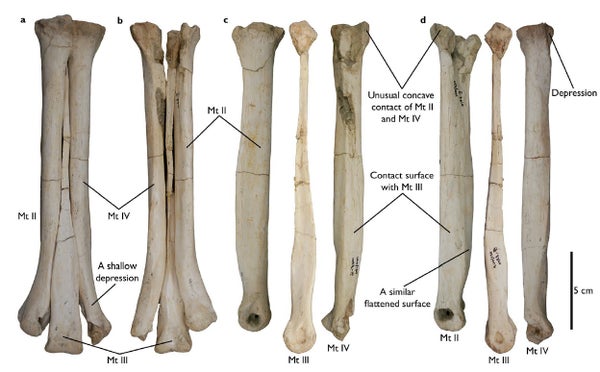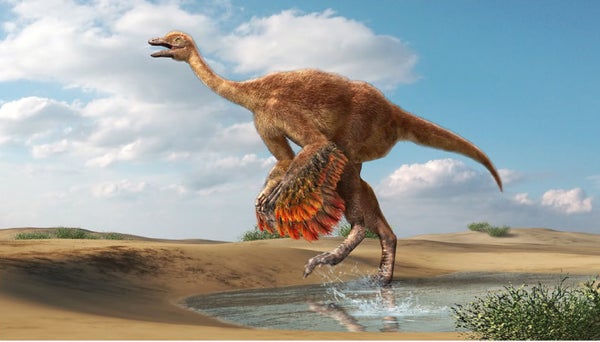This article was published in Scientific American’s former blog network and reflects the views of the author, not necessarily those of Scientific American
We haven't found all the dinosaurs yet. Not even close. Even at the current breakneck rate of discovery - a new species announced every two weeks ago - we're really only just starting to get a tally on the various "terrible lizards" that used to roam our planet. In fact, even places that have been searched for decades are yielding previously-unknown dinosaurs.
Aepyornithomimus tugrikinensis, one of the latest species to enter the scientific canon, is one such dinosaur. As paleontologist Chinzorig Tsogtbaatar and colleagues describe, the fossils of this Cretaceous creature were found in the Cretaceous Djadokhta Formation of Mongolia. Paleontologists have been working this area for almost 100 years, turning up plenty of ghostly white fossils. Yet Aepyornithomimus is unlike anything found there before.
The dinosaur is only known from a left foot. Nevertheless, the anatomy of those bones show that this dinosaur is an ornithomimid - one of the ostrich-like "bird mimic" dinosaurs - that are extremely rare in these fossil beds. It's only the third specimen of these dinosaurs found in the area. More than that, the bones don't match any previously-known dinosaur. This foot, Tsogtbaatar and coauthors propose, belongs to a new dinosaur that padded around the ancient desert and justify the title Aepyornithomimus for its resemblance to the bones of the extinct, flightless elephant bird.
It's not as if the fossil record is unlimited. It's only a fraction of a fraction of a fraction of all life that ever existed, and there may come a point in the distant future where paleontological wellsprings start to run dry. For now, though, finds like Aepyornithomimus remind us that we're lucky to have any fossils at all, and that even classic localities paleontologists know like the backs of their hands can still offer surprises.

Foot bones of Aepyornithomimus. Credit: Tsogtbaatar et al. 2017
Fossil Facts
On supporting science journalism
If you're enjoying this article, consider supporting our award-winning journalism by subscribing. By purchasing a subscription you are helping to ensure the future of impactful stories about the discoveries and ideas shaping our world today.
Name: Aepyornithomimus tugrikinensis
Meaning: Aepyornithomimus means "elephant bird mimic", while tugrikinensis refers to the area of Mongolia the fossils were found in.
Age: Cretaceous, between 83 and 72 million years old.
Where in the world?: Central Sayr, Mongolia.
What sort of organism?: An ornithomimid dinosaur.
How much of the organism’s is known?: An articulated left foot.
Reference:
Tsogtbaatar, C., Kobayashi, Y., Khishigjav, T., Currie, P., Watabe, M., Rinchen, B. 2017. First ornithomimid (Theropoda, Ornithomimosauria) from the Upper Cretaceous Djadokhta Formation of Tögrögiin Shiree, Mongolia. Scientific Reports. doi: 10.1038/s41598-017-05272-6
Previous Paleo Profiles:
The Light-Footed Lizard The Maoming Cat Knight’s Egyptian Bat The La Luna Snake The Rio do Rasto Tooth Bob Weir's Otter Egypt's Canine Beast The Vastan Mine Tapir Pangu's Wing The Dawn Megamouth The Genga Lizard The Micro Lion The Mystery Titanosaur The Echo Hunter The Lo Hueco Titan The Three-Branched Cicada The Monster of Minden The Pig-Footed Bandicoot Hayden's Rattlesnake Demon The Evasive Ostrich Seer The Paradoxical Mega Shark The Tiny Beardogs The Armored Fish King North America's Pangolin The Invisible-Tusked Elephant The Mud Dragon The Spike-Toothed Salmon The Dream Coast Crocodile Buriol's Robber Ozimek's Flyer The Northern Naustoceratopsian The High Arctic Flyer The Tomatillo From the End of the World The Short-Faced Hyena The Mighty Traveler from Egg Mountain Keilhau's Ichthyosaur Mexico's Ancient Horned Face Mauricio Fernández's Plesiosaur New Zealand's Giant Dawn Penguin The Orange Sea Lion Mongolia's Ginkgo Cousin The Geni River Frog Isabel Berry's Dinosaur The Whale Caiman The Moab Lizard Yang Zhongjian's Lizard The Little Anubis The Shuangbai Lizard The Wyvern Dinosaur The "Need Helmet" Dinosaur The Jianianhua Dragon The Liaoning Hunter The Dalian Lizard Crompton's Aleodon Jenkins' Amphibian Serpent From the Chinle The Large Ancestor Lizard The Crown Tooth Currie's Alberta Hunter
